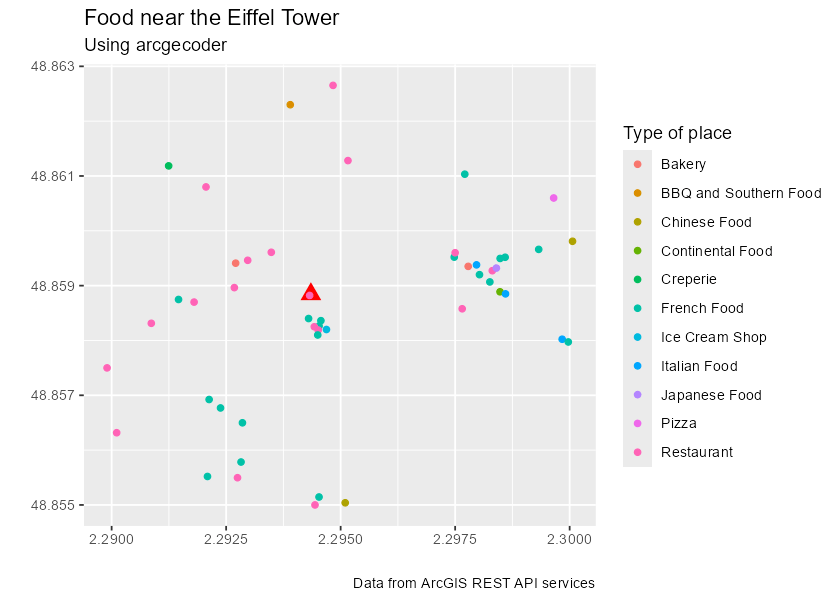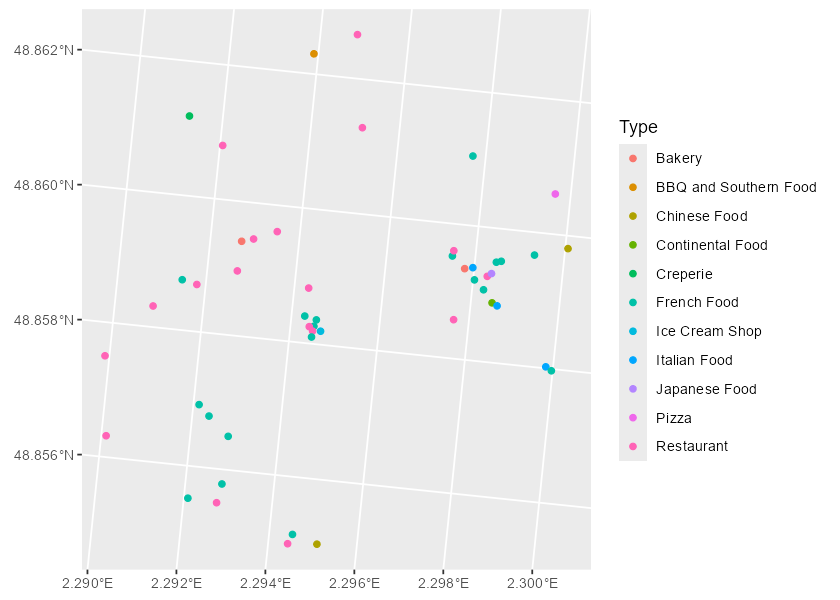The goal of arcgeocoder is to provide a light interface for geocoding addresses and reverse geocoding location trough the ArcGIS REST API Geocoding Service.
Full site with examples and vignettes on https://dieghernan.github.io/arcgeocoder/
Why arcgeocoder?
arcgeocoder is a package that provides a lightweight interface for geocoding and reverse geocoding with the ArcGIS REST API service. The goal of arcgeocoder is to access the ArcGIS REST API with fewer dependencies, such as curl. In some situations, curl may not be available or accessible, so arcgeocoder uses base functions to overcome this limitation.
The interface of apigeocoder is built with the aim of easing the access to all the features provided by the API. The API endpoints used by arcgeocoder are findAddressCandidates and reverseGeocode, which can be accessed without the need for an API key.
Recommended packages
There are other packages much more complete and mature than arcgeocoder, that presents similar features:
- tidygeocoder (Cambon et al. 2021). Allows to interface with ArcGIS, Nominatim (OpenStreetMaps), Google, TomTom, Mapbox, etc. for geocoding and reverse geocoding.
- nominatimlite (Hernangómez 2024). Similar to arcgeocoder but using data from OpenStreetMaps trough the Nominatim API service.
Installation
Install arcgeocoder from CRAN with:
install.packages("arcgeocoder")You can install the developing version of arcgeocoder with:
remotes::install_github("dieghernan/arcgeocoder")Alternatively, you can install arcgeocoder using the r-universe:
# Install arcgeocoder in R:
install.packages("arcgeocoder",
repos = c(
"https://dieghernan.r-universe.dev",
"https://cloud.r-project.org"
)
)Usage
Geocoding and reverse geocoding
Note: examples adapted from tidygeocoder package
In this first example we will geocode a few addresses using the arc_geo() function. Note that arcgeocoder works straight away, and you don’t need to provide any API key to start geocoding!
library(arcgeocoder)
library(dplyr)
# create a dataframe with addresses
some_addresses <- tribble(
~name, ~addr,
"White House", "1600 Pennsylvania Ave NW, Washington, DC",
"Transamerica Pyramid", "600 Montgomery St, San Francisco, CA 94111",
"Willis Tower", "233 S Wacker Dr, Chicago, IL 60606"
)
# geocode the addresses
lat_longs <- arc_geo(some_addresses$addr, lat = "latitude", long = "longitude")
#> | | | 0% | |================= | 33% | |================================= | 67% | |==================================================| 100%Only a few fields are returned from the geocoder service in this example, but full_results = TRUE can be used to return all of the data from the geocoder service.
| query | latitude | longitude | address | score | x | y | xmin | ymin | xmax | ymax | wkid | latestWkid |
|---|---|---|---|---|---|---|---|---|---|---|---|---|
| 1600 Pennsylvania Ave NW, Washington, DC | 38.89768 | -77.03655 | 1600 Pennsylvania Ave NW, Washington, District of Columbia, 20500 | 100 | -77.03655 | 38.89768 | -77.03755 | 38.89668 | -77.03555 | 38.89868 | 4326 | 4326 |
| 600 Montgomery St, San Francisco, CA 94111 | 37.79517 | -122.40278 | 600 Montgomery St, San Francisco, California, 94111 | 100 | -122.40278 | 37.79517 | -122.40378 | 37.79417 | -122.40178 | 37.79617 | 4326 | 4326 |
| 233 S Wacker Dr, Chicago, IL 60606 | 41.87877 | -87.63580 | 233 S Wacker Dr, Chicago, Illinois, 60606 | 100 | -87.63580 | 41.87877 | -87.63680 | 41.87777 | -87.63480 | 41.87977 | 4326 | 4326 |
To perform reverse geocoding (obtaining addresses from geographic coordinates), we can use the arc_reverse_geo() function. The arguments are similar to the arc_geo() function, but now we specify the input data columns with the x and y arguments. The dataset used here is from the geocoder query above. The single line address is returned in a column named by the address.
reverse <- arc_reverse_geo(
x = lat_longs$longitude,
y = lat_longs$latitude,
address = "address_found"
)
#> | | | 0% | |================= | 33% | |================================= | 67% | |==================================================| 100%| x | y | address_found |
|---|---|---|
| -77.03655 | 38.89768 | White House, 1600 Pennsylvania Ave NW, Washington, DC, 20500, USA |
| -122.40278 | 37.79517 | Mbia Insurance Corporation, 600 Montgomery St, San Francisco, CA, 94111, USA |
| -87.63580 | 41.87877 | Market Creations, 233 S Wacker Dr, #2, Chicago, IL, 60606, USA |
It is possible also to search for specific locations within or near a reference are or location using category filtering. See more information in the documentation of the data base arc_categories.
In the following example we would look for POIs related with food (i.e. Restaurants, Coffee Shops, Bakeries) near the Eiffel Tower in France.
library(ggplot2) # For plotting
# Step 1: Locate Eiffel Tower, using multifield query
eiffel_tower <- arc_geo_multi(
address = "Tour Eiffel",
city = "Paris",
countrycode = "FR",
langcode = "FR",
custom_query = list(outFields = "LongLabel")
)
# Display results
eiffel_tower %>%
select(lon, lat, LongLabel)
#> # A tibble: 1 × 3
#> lon lat LongLabel
#> <dbl> <dbl> <chr>
#> 1 2.29 48.9 Tour Eiffel, Avenue Gustave Eiffel, 75007, 7e Arrondissement, Par…
# Use lon,lat to boots the search and using category = Food
food_eiffel <- arc_geo_categories("Food",
x = eiffel_tower$lon,
y = eiffel_tower$lat,
limit = 50, full_results = TRUE
)
# Plot by Food Type
ggplot(eiffel_tower, aes(x, y)) +
geom_point(shape = 17, color = "red", size = 4) +
geom_point(data = food_eiffel, aes(x, y, color = Type)) +
labs(
title = "Food near the Eiffel Tower",
subtitle = "Using arcgecoder",
color = "Type of place",
x = "",
y = "",
caption = "Data from ArcGIS REST API services"
)
arcgeocoder and r-spatial
It is straightforward to convert the results of arcgeocoder to an sf object (geospatial format):
library(sf)
food_eiffel_sf <- st_as_sf(food_eiffel,
coords = c("lon", "lat"),
# The CRS of the resulting coords is here
crs = eiffel_tower$wkid
)
food_eiffel_sf
#> Simple feature collection with 50 features and 75 fields
#> Geometry type: POINT
#> Dimension: XY
#> Bounding box: xmin: 2.289018 ymin: 48.85511 xmax: 2.299797 ymax: 48.86257
#> Geodetic CRS: WGS 84
#> # A tibble: 50 × 76
#> q_category q_x q_y q_bbox_xmin q_bbox_ymin q_bbox_xmax q_bbox_ymax
#> * <chr> <dbl> <dbl> <lgl> <lgl> <lgl> <lgl>
#> 1 Food 2.29 48.9 NA NA NA NA
#> 2 Food 2.29 48.9 NA NA NA NA
#> 3 Food 2.29 48.9 NA NA NA NA
#> 4 Food 2.29 48.9 NA NA NA NA
#> 5 Food 2.29 48.9 NA NA NA NA
#> 6 Food 2.29 48.9 NA NA NA NA
#> 7 Food 2.29 48.9 NA NA NA NA
#> 8 Food 2.29 48.9 NA NA NA NA
#> 9 Food 2.29 48.9 NA NA NA NA
#> 10 Food 2.29 48.9 NA NA NA NA
#> # ℹ 40 more rows
#> # ℹ 69 more variables: address <chr>, score <int>, x <dbl>, y <dbl>,
#> # Loc_name <chr>, Status <chr>, Score <int>, Match_addr <chr>,
#> # LongLabel <chr>, ShortLabel <chr>, Addr_type <chr>, Type <chr>,
#> # PlaceName <chr>, Place_addr <chr>, Phone <chr>, URL <chr>, Rank <int>,
#> # AddBldg <chr>, AddNum <chr>, AddNumFrom <chr>, AddNumTo <chr>,
#> # AddRange <chr>, Side <chr>, StPreDir <chr>, StPreType <chr>, …
See additional articles showing how arcgeocoder can be use in combination with leaflet to create dynamic maps and with sf and terra to create static maps.
Citation
Hernangómez D (2024). arcgeocoder: Geocoding with the ArcGIS REST API Service. doi:10.32614/CRAN.package.arcgeocoder, https://dieghernan.github.io/arcgeocoder/.
A BibTeX entry for LaTeX users is
@Manual{R-arcgeocoder,
title = {{arcgeocoder}: Geocoding with the {ArcGIS} {REST} {API} Service},
doi = {10.32614/CRAN.package.arcgeocoder},
author = {Diego Hernangómez},
year = {2024},
version = {0.2.0},
url = {https://dieghernan.github.io/arcgeocoder/},
abstract = {Lite interface for finding locations of addresses or businesses around the world using the ArcGIS REST API service <https://developers.arcgis.com/rest/geocode/api-reference/overview-world-geocoding-service.htm>. Address text can be converted to location candidates and a location can be converted into an address. No API key required.},
}